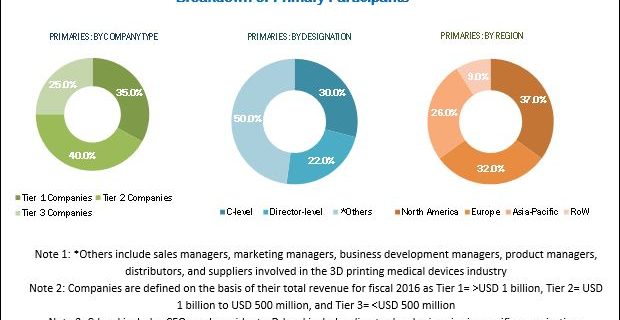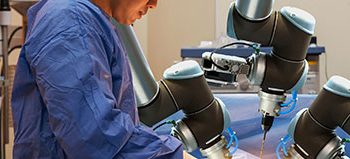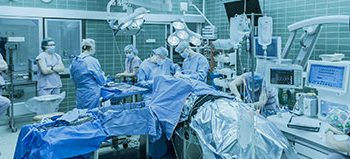
Major factors driving the growth of this market Technological advancements, increasing public-private funding, easy development of customized medical products, and growing applications in the healthcare industry.
Moreover, direct digital manufacturing, the expiry of key patents in the coming years, and the growing demand for organ transplant provide significant growth opportunities in the Global 3D Printing Medical Devices Market. However, the stringent regulatory process and the dearth of trained professionals may hinder the growth of this market during the forecast period.
3D Printing Medical Devices Market – Market Dynamics
Drivers
- Technological advancements in 3D printing
- Increasing public-private funding for 3D printing activities
- Easy development of customized medical products using 3D printing
- Growing applications of 3D printing in the healthcare industry
Restraints
- Stringent regulatory process for the approval of 3D-printed medical devices
- Dearth of trained professionals
Opportunities
- Direct digital manufacturing
- Reconfiguration of supply chain models of medical device manufacturers
- Expiry of key patents in the 3D printing industry
- Growing demand for organ transplant
Challenges
- High cost of 3D printing systems
- Socio-ethical concerns related to the use of 3D-printed products
- Process control and understanding
To know about the assumptions considered for the study, download the pdf brochure
3D printing technologies in the medical field have been used to craft a variety of surgical tools that can be affordably tailored to match particular surgeon or patient preferences. These instruments are made using metals that are sterilizable, biocompatible, and non-toxic, and do not cause allergic reactions or shed particles.
The market for this segment is mainly driven by increasing awareness among people about 3D printed products, rapid production rate, and cost benefits.
On the basis of component, the global 3D printing medical devices market is segmented into three broad categories, namely, equipment, materials, and software & services. The equipment segment is expected to register the highest growth from 2017 to 2022.
The development of technologically advanced 3D printing equipment by leading market players for a number of healthcare applications and the rising adoption of 3D printing for manufacturing medical products are the key factors driving the demand for 3D printing equipment in the healthcare industry.
Know more about 3D Printing Medical Devices: https://www.marketsandmarkets.com/PressReleases/3d-printing-medical-devices.asp
On the basis of technology, the 3D printing medical devices market is segmented into electron beam melting (EBM), laser beam melting (LBM), photopolymerization, droplet deposition or extrusion-based technologies, and three-dimensional printing (3DP) or adhesion bonding or binder jetting.
The LBM segment is expected to register the highest growth during the forecast period. This technology is primarily used for producing small parts with ultimate accuracy such as dental copying and hybrid parts of machines for minimally invasive surgery.
In 2016, North America accounted for the largest share of the market due to factors such as increasing government initiatives and rising demand for organ transplants. However, the Asia-Pacific region is expected to register the highest CAGR during the forecast period.
The establishment of new 3D printing research, training, and education centers, and rising efforts by leading market players for expanding their distribution networks in emerging Asian countries are factors propelling the growth of the 3D printing medical devices market in Asia-Pacific.
Request for Sample Pages on 3D Printing Medical Devices
Photopolymerization is the most widely adopted technology used in the 3D printing process; however, there are several alternative technologies that can be used in this process. Droplet Deposition (DD) or Extrusion based Technologies, Laser Beam Melting, Electron Beam Melting, and Three Dimensional Printing (3DP) or Adhesion Bonding or Binder Jetting are few such alternatives that are considered in different cases.
Laser beam melting is a rapidly growing 3D printing technology that allows the fabrication of complex, multifunctional metal or alloy parts by the CAD-directed melting of precursor powder beds using a laser as the source of energy. It is the best-suited technology for the production of small parts, such as dental copings and hybrid parts of machines for minimally invasive surgery, due to its high accuracy.
On the other hand, electron beam melting is a new technology process and has various advantages over other technologies. With a high melting rate, it is suitable for manufacturing oxygen-sensitive metals such as titanium and is free from oxidation issues as it takes place under vacuum. Thus, in the near future, EBM may be the fastest-growing platform for 3D printing due to its higher energy density and scanning method with low operating costs.
Purchase Report of 3D Printing Medical Devices Market @ https://www.marketsandmarkets.com/Purchase/purchase_reportNew.asp?id=90799911


